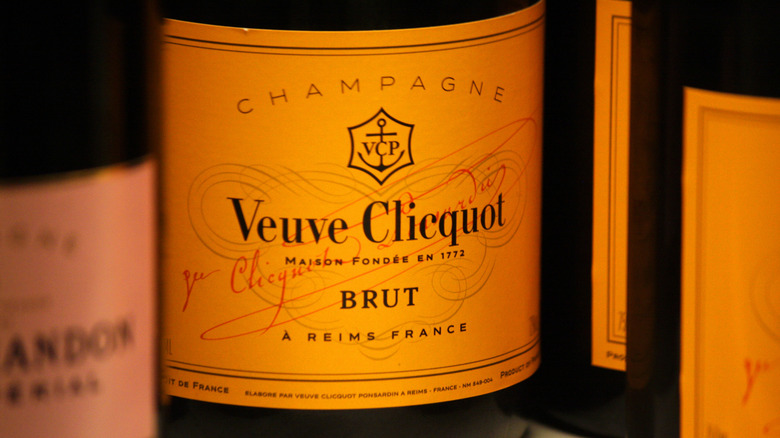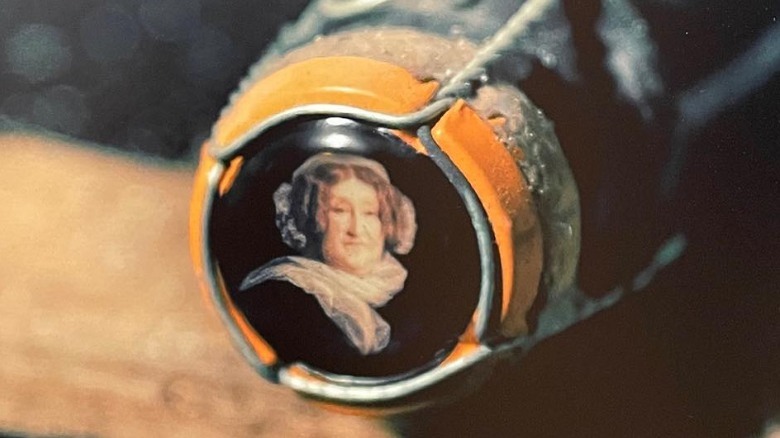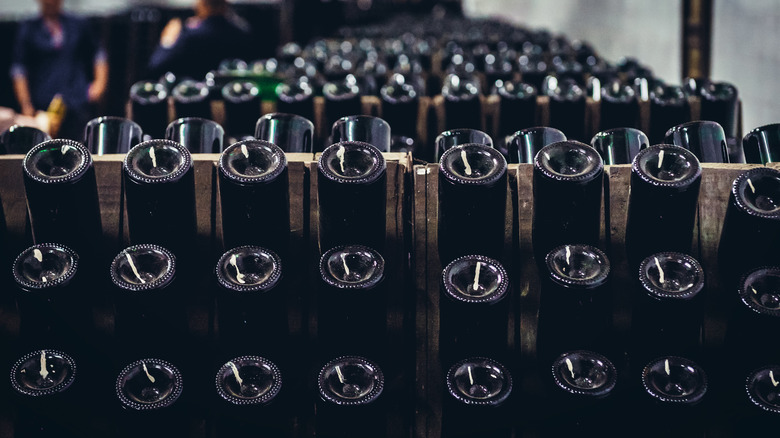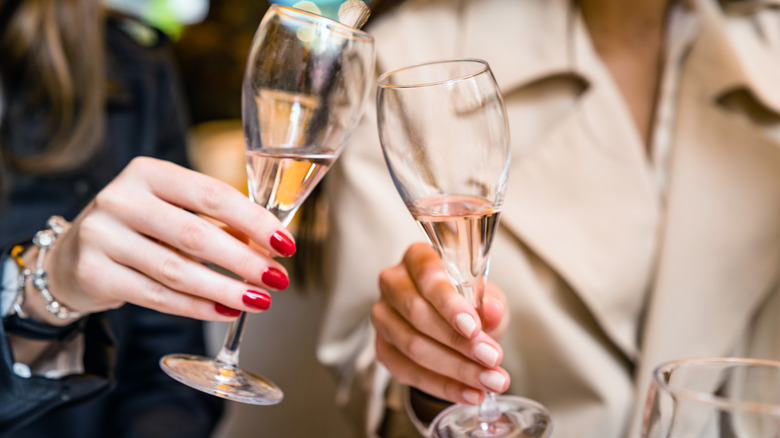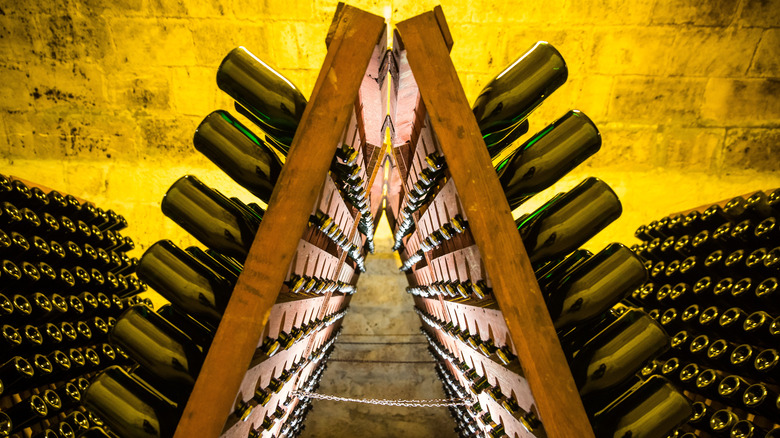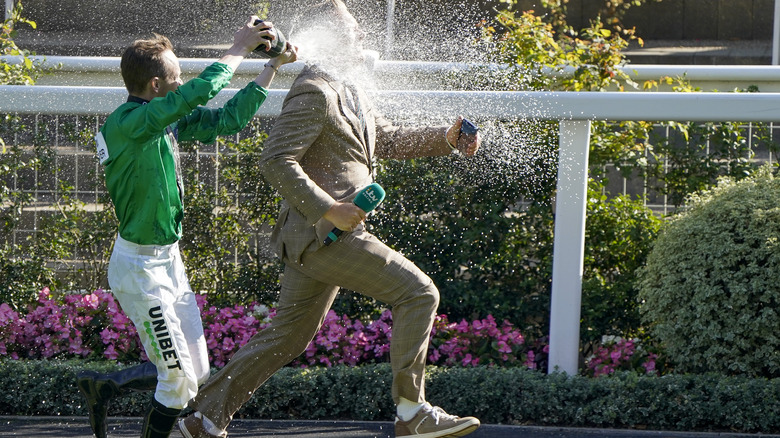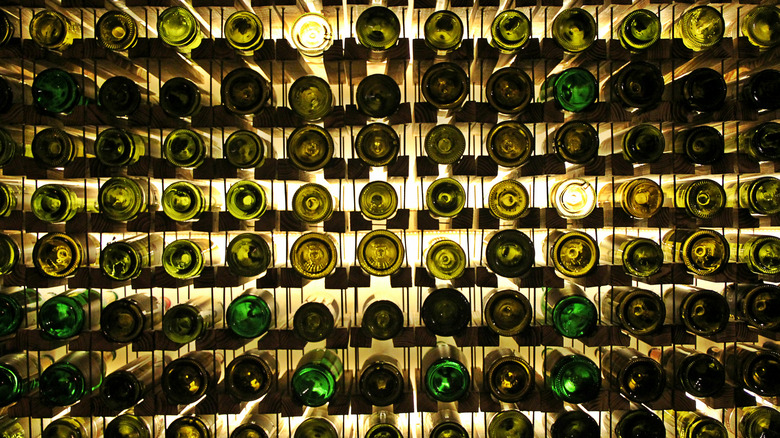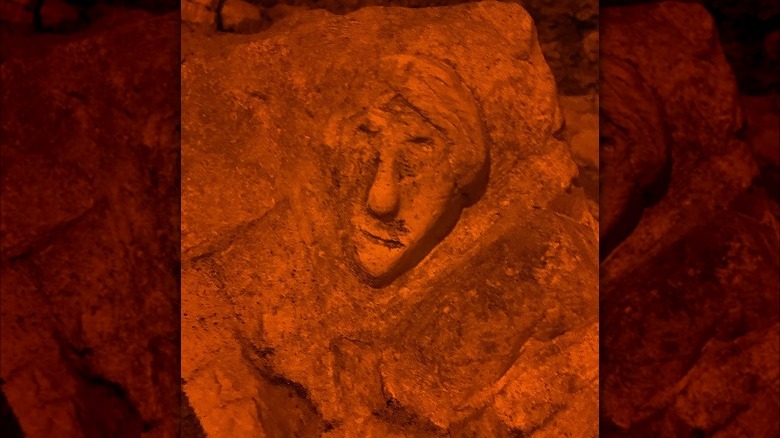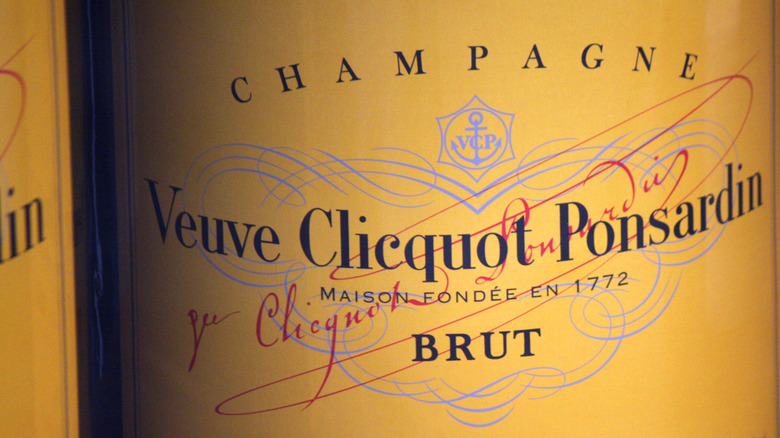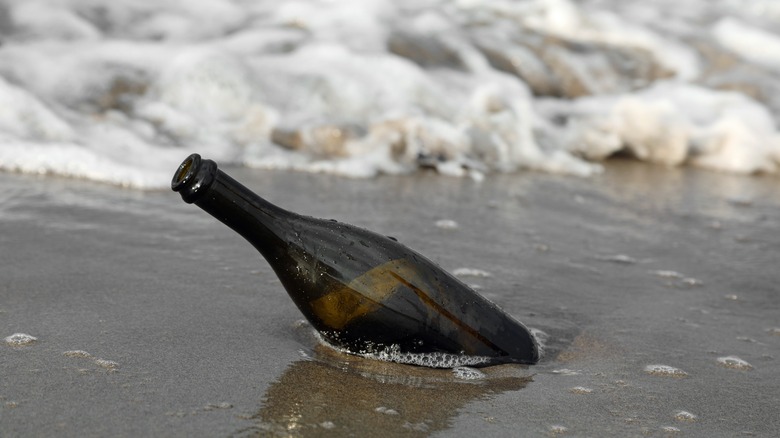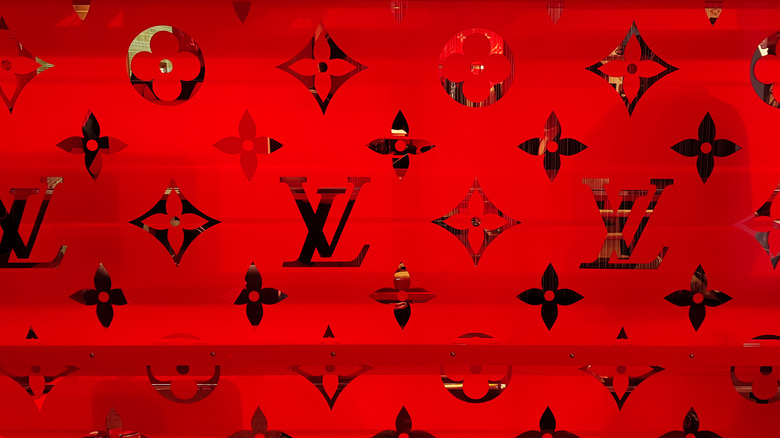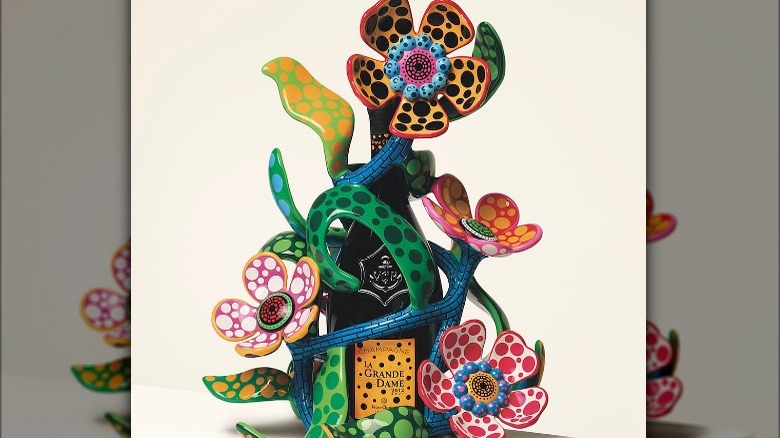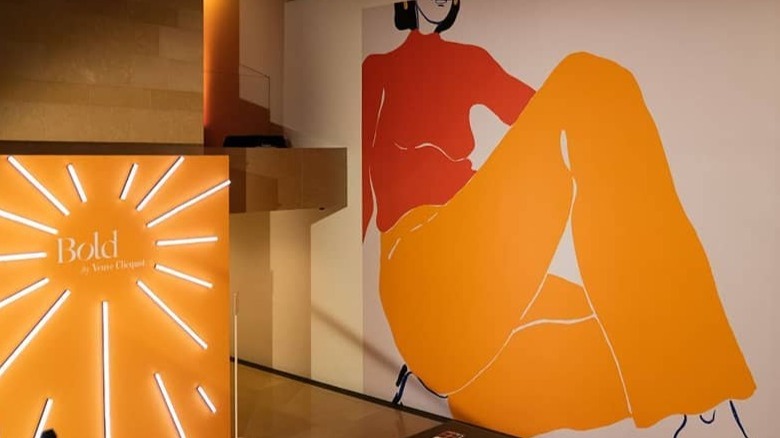The Untold Truth Of Veuve Clicquot
If there is one drink that is synonymous with luxury, it's Champagne! Champagne is usually reserved for special occasions: to ring in the New Year, toast newlyweds, or mark life's major milestones. The cold glass of bubbly boldly declares, now this is something worth celebrating. Simply put, the history of Champagne is one of triumph. From being red wine's paler and less tempting sister to becoming the favored drink of the French monarchy and now tastemaker in modernity, Champagne has long been on a meteoric rise (via CrushWineXP and Experi).
As one might have already heard, Champagne hails exclusively from the Champagne region of France. This region is situated in the northernmost part of the country, with Reims being the spiritual center of Champagne production. Among the stars of Champagne is the iconically dark yellow-labeled Veuve Clicquot. And while being revolutionary may not, on the other hand, be synonymous with all Champagne, it certainly is with this now-classic brand.
But, before diving into the thrilling history surrounding Clicquot, it's fitting to get acquainted with the brand's flavor profile. Like all good Champagnes, Veuve Clicquot is wondrously acidic and toasty, with immediate notes of citrus fruits followed by a hint of brioche (via Wine.com). As the wine site proudly proclaims, Veuve Clicquot strikes a delicate balance between "structure and finesse." This is a Champagne that does well on its own and accompanies a meal. But really, the Veuve Clicquot doesn't just have good taste; it has a fascinating past, present, and future.
Madame Clicquot became the grande dame of the champagne world
There's an undeniable femininity to Veuve Clicquot Champagne, namely in its founding! The word "veuve" means widow in French, referring to the marital status of Barbe-Nicole Clicquot-Ponsardin, pioneer and de facto founder of the brand (via The Smithsonian). According to the magazine, after her husband's untimely death, Madame Clicquot revived her and her late husband's failing wine business by risking her entire inheritance to support it. Still on the brink of failure and having once again asked her father-in-law to make an investment, Barbe-Nicole took one last major risk. With the end of the Napoleonic Wars, a new market opened in Russia, and Clicquot's particularly sweet Champagne took the market by storm, as noted by The Smithsonian. The brand wasn't just saved; it soon became a household name in Russia, France, and beyond. It was at this point that Madame Clicquot began to be cemented as the "la grande dame of Champagne" (via Haute Living).
The Guardian credits Madame Clicquot as the "first" businesswoman whose shrewdness, boldness, and stick-to-itiveness not only brought a struggling Champagne business to life but revolutionized the Champagne industry as a whole. Even nowadays, Barbe-Nicole not only still holds a place as one of the most important figures in the history of Champagne, but she is also a pioneer in Champagne manufacturing and a role model to men and women alike. It's no wonder that a biography has been written about her!
Madame Clicquot invented the riddling process
The widow had more tricks up her sleeves than strategic marketing. The Madame was responsible for perfecting the riddling process, otherwise known as remuage. Riddling is an extremely important step in Champagne production, as it removes the sediment collected in each Champagne bottle due to individual fermentation (change via Escoffier Online). Without riddling, Champagne takes on a cloudy appearance with lots of dead yeast collecting at the bottle's bottom (via The Smithsonian Magazine). This certainly isn't as appealing as the clear and bright Champagne we are familiar with today.
While other methods existed to remove sediment from Champagne bottles, it was Madame Clicquot that devised a better means of removing it. She designed a riddling rack, where each Champagne bottle could be gradually turned over a six-week period so that the drink's sediment would collect and the cork could be properly and easily removed (via Wine Magazine).
According to The Smithsonian Magazine, compared to previously existing methods, Clicquot's was much more efficient and faster. Allegedly, as per the magazine, Champagne made with Clicquot's method also tasted better. But, more importantly, Clicquot's method made Champagne able to be produced in mass for the first time and paved the way for further innovation in riddling.
The widow and her team were also responsible rosé champagne
Ever one for breaking convention, it was through Veuve's guidance and boldness that the brand first brought together two beloved icons: rosé and Champagne. Rosé Champagne is particularly fresh and especially fruity, given both rosé and Champagne's individual flavor profiles (via Wine.com). As the site suggests, Veuve Clicquot's rosé Champagne or pink Champagne is both bold and elegant in taste and sight.
As Vinovest describes, Clicquot's Champagne was made by simply mixing red wine with Champagne. While this seems simple, at the time, it was revolutionary. Previously, pink Champagne was made by mixing elderberry juice with Champagne, giving it that iconic pink hue. Clicquot instead turned towards other wine harvested in the Champagne Region. She selected the robust Pinot Noir to give the rosé Champagne a new, stronger, and more nuanced character.
As The Buyer observes, Madame Clicquot had once again redesigned and reset the norm for the Champagne Industry. Nowadays, red wine, specifically Pinot Noir, is the standard for rosé Champagnes. Ever French in spirit, the site asserts that a good pink Champagne is a sum of its parts; nothing but the best Pinot and best Champagne! As the old adage goes, sharing is caring, and Wine.com suggests pairing a bottle with a good friend or two.
Veuve Clicquot created the first ever vintage Champagne in its region
There are many ways to differentiate between Champagne types, but one of the most important distinctions is vintage versus non-vintage. Vintage Champagnes are, as defined by Vine Pair, produced from three major grape groups and aged for a minimum of three years. The sommelier interviewed for the article asserts that the aging sets vintage Champagnes apart; it takes up space, is labor and time-intensive, and adds the "luxury" element to the already luxurious product. Non-vintage Champagnes, on the other hand, are sourced from multiple harvests, sometimes up to 20 years apart. This produces a "broader" taste that tends to encapsulate the specific qualities that define the vineyard. The article succinctly summarizes vintage Champagnes as unique bottles with high variability. Non-vintage Champagnes, on the other hand, can be understood as "house" Champagnes that showcase the brand's notable qualities.
The Champagne region's first ever vintage is credited to Madame Clicquot in 1810 (via Vinovest). It's safe to say that Nicole-Barbe was not only a shrewd business-woman but also a visionary and artist. She pushed Champagne to its boundaries while elevating it to its highest level. All the while, her deep understanding and appreciation of the drink made it possible for such amazing innovation to be carried out through one person.
The Champagne holds a royal warrant from the Queen of England
It wasn't just the French and Russian monarchies that Veuve Clicquot fell into favor with; the Champagne held a royal warrant from Queen Elizabeth herself. A Royal Warrant of Appointment is, as per The Royal Warrant Holder's Association, an official recognition of goods or services provided to the royal household. Royal Warrants can only be issued by the Monarch, i.e., the Queen or the Prince of Wales, and can be looked at as an endorsement straight from the regency to you. According to the site, nowadays, there are 800 active royal warrants.
All of this speaks for the staying power and prowess of the Veuve Clicquot! According to the Royal Warrant Holders Association, this classic Champagne brand is poured at every major social event. As the site flatteringly describes, a bottle of Veuve Clicquot is the perfect compliment to any celebratory occasion.
Chalk quarries were and are utilized for Champagne storage
It's not for nothing that Champagne only comes from the Champagne region of France. Abundant to this region are chalk quarries, known as crayères, that have been long used to house bottles of Champagne. So old are these quarries that some date back to Roman settlements (via Messy Nessy Chic). Made out of solid chalk, these quarries provided a naturally cool space with no sunlight to allow the Champagne to ferment and age.
One could easily argue that the chalk quarries are just as important to Champagne production as the climates and grapes. It's fair to say that the Champagne region truly has the perfect conditions to make a truly sensational wine. It seems UNESCO agrees, and nowadays, the chalk quarries, as well as Champagne hillsides and houses, are considered UNESCO World Heritage sites. The chalk quarries still remain in use today and house countless bottles of bubbles (via Vinovest).
These crayères were multifunctional during both World Wars
War isn't what comes to mind when thinking of Champagne; in fact, it's probably the furthest thing from it. But, as both World Wars raged in France, the chalk quarries were repurposed to meet the needs of the time and community. World War I, which was largely concentrated on the Western Front, affected the Champagne industry in many ways. As troops marched throughout the region, the chalk quarries offered a place of refuge for citizens (via SevenFifty Daily). The website reports just about all aspects of "above" ground life being moved to the crayères: planks of wood were put on top of Champagne bottles to make desks, classes and religious services held in the quarries, and the cellars that once provided indulgence to a population now offered shelter.
Although the Champagne countryside suffered immensely from the war, the cellars remained largely undamaged according to the city. During this time, the Champagne industry largely moved underground in order to keep bottles safe and production in the hope of better times. It wasn't uncommon for civilians and soldiers, French and German alike, to carve their ruminations into the somewhat soft chalk walls. Nowadays, the crayéres remain as both a testament to Champagne and history.
The bubbly's distinct yellow labeling is copyrighted
The yellow label on a bottle of Veuve Clicquot is immediately distinguishable with its bright yellow label in the center of that classic dark green bottle. The yellow label was first printed near the end of the 19th century (via Veuve Clicquot). According to the site, the yellow label remained bold and unusual for the time being. But, of course, given the brand, that's par for the course.
In 2014, the MCHS Champagne conglomerate, to which Veuve Clicquot belongs, discovered that select Italian Proseccos used a similar orange label to the French Champagne. Of course, with so much confusion surrounding Champagne, Prosecco, and sparkling wine, there was a case to be made that the Prosecco companies were intentionally playing off of Veuve Clicquot's distinct label to confuse buyers (via Bugnion). While the label did not sue the winery, it did (strongly) suggest the smaller winery "evolve" their label to avoid confusion. With well over a century of history, the yellow label is an essential part of the entire Veuve Clicquot experience.
A shipwrecked bottle of Veuve Clicquot sold for $43,900
In 2010, a shipwreck was discovered off the coast of Finland with around 168 bottles of Veuve-Clicquot Champagne (via The Drinks Business). As it turns out, the Baltic Ocean provided the perfect conditions to preserve the luxury drink; it was dark and cool, which kept them in nearly perfect condition, as reported by the site. Experts cited the shipwreck as being around 170 years old and en route to the Russian market. The bottles provided valuable insight into the composition of classic Champagne. The BBC went so far as to describe the shipwrecked Champagne's condition as "exquisite."
While the Champagne's CO2, i.e., bubbly, had long since dissipated, the core composition of the drink remained. These Veuve Clicquot bottles contained much more sugar than what would be found nowadays, explains The Drinks Business, as tastes surrounding wine back in the day were much sweeter. The article explains it was not uncommon for additional sugar to be added at the table to sweeten wines up even more!
Less appetizingly, the bottles also contained traces of both arsenic and lead, which The Drinks Business credits to common pesticide use and the iron fittings on wine barrels, respectively. Despite the (slight) presence of toxins, one bottle sold for a record-setting $44,000 in a 2011 auction.
Veuve Clicquot is a part of the Louis Vuitton house
With a price tag of $26,800 for a Champagne case, it suffices to say that a Louis Vuitton and Champagne collection is luxury on luxury, decadence on decadence. The Veuve Clicquot company was acquired in 1986 by Louis Vuitton to become integrated into the legendary Maison's repertoire (via Veuve Clicquot). It may not make sense at first; after all, what could a company do with clothing and Champagne? But, as reported by AP News in 1990, the Louis Vuitton company believed that luxury clothes and drink are aligned in "strategic" interests. Basically, individuals who are likely to indulge in luxury drinks will probably also indulge in luxury clothes and vice versa. Thus, Louis Vuitton profits from both Champagne and the case. By the end of the '90s, Louis Vuitton built a "Champagne constellation" by acquiring Veuve Clicquot, Moët & Chandon, among other Champagne brands. As observed by Bloomberg News, this has become a success story for Louis Vuitton, now the largest luxury goods seller worldwide.
Veuve Clicquot is ringing in 250 years with a female-driven art show
To celebrate Veuve Clicquot's astonishing 250th anniversary, the Champagne company threw an art show showcasing diverse female artists. As reported by The CEO Magazine, the show displayed the free-spiritedness, or better yet, the audacity that has defined the brand, and the woman, from the very start. As reported by the website, the female artists were given the "carte blanche" to display and celebrate Veuve Clicquot and the grande dame in every way possible. What resulted was a vibrant show filled with sculptures, light installations, and modern portraits.
Modern and critically-acclaimed artist Yayoi Kusama, who painted one portrait and sculpted one piece for the show, also featured a limited edition of Veuve Clicquot Grande Dame Champagne. As the design-site Wallpaper describes, Kusama's interpretations of the brand are whimsical, celebratory, and bright. The site makes an apt comparison that the artist's trademark polka dots perfectly mimic the very bubbles that make Veuve Clicquot so darn good.
Veuve Clicquot still seeks to encourage female entrepeneurs
Beyond the art world, the Veuve Clicquot brand seeks to encourage female entrepreneurs and their pursuits with its Bold by Veuve Clicquot award. According to the company's site, the award is nearing its 50-year mark and is a long-cherished tradition. Each year, exceptional entrepreneurs are awarded The Bold Woman Award and The Bold Future Award. The award seeks to reward those who have contributed to their company's success, transformed the market and brought about an ethical change in the company, all huge accomplishments and very in line with Veuve's character (via News24). Recipients of the Bold Woman Award and Bold Future Award are rewarded with a trip to Reims to be immersed in Maison's culture, history, and tradition.
But this isn't the only awards program; other international programs, which are described as "resolutely audacious," seek to bring female business leaders together (via Louis Vuitton Moët Hennessy). The program aims to not only bring together female entrepreneurs in conversation and connection but also to offer opportunities to build confidence and mentoring through guided programs and initiatives.
Millennial women stay at the forefront of the brand's marketing strategy
It seems like women remain near and dear to the Champagne brand, which may again prove strategic as it seeks to make the bubbly the millennial women's drink of choice (via Forbes). After all, as the site points out: What's better than a special occasion drink for any and all occasions! The business magazine notes the current marketing strategy as straddling the line between everyday use with the original atmosphere of luxury. As Forbes notes, millennial women provide a promising market that may be the most willing (and able) to raise a glass at casual dinner parties and important business meetings alike. Americans, in general, buy a lot of Veuve Clicquot but on average only drink less than half a glass of Champagne per year. This could prove the perfect opportunity to improve and change perceptions surrounding the luxury drink.
As observed by CNBC, Vueve Clicquot launched digital short films targeting millennial women. It seems like the Veuve Clicquot has hit a full circle moment, as a woman who originally crafted the drink now seeks to find a home in the hearts of entrepreneurial women once again.
